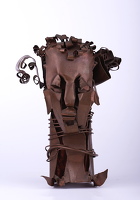
Leila Faithful
Sculpted Female Head, c. 1960

Leila Faithful (1896 - 1994)
Born in 1896, Leila Faithful's creative work was largely inspired by the 1900s and 1910s. The first major Post-impressionism movement in the early years of the twentieth century is generally considered to be the Fauves, a group for whom intense, other-worldly colours and vibrant brushstrokes were a key component of painting, and who counted Henri Matisse as a member. In Paris during the same time, a young Pablo Picasso painted his acclaimed Blue and Rose periods. By the end of the decade, along with Georges Braque, he had developed the first fracturing of illustrative reality with Analytical Cubism. The first twenty years of the Twentieth Century can be viewed to be among the most fertile, and are noted as the time in art history when modern and modernist ideas first took hold of cultural production. The new order and rationality, alongside mechanisation in modes of production, saw art’s parallel discipline of architecture develop at an astonishing rate in the work of designers like Le Corbusier and Gerrit Rietveld. It was the era of the Bauhaus and the idea of a common discipline amongst the creative arts as a whole. Most, if not all, of the core art movements we associate with modern and contemporary art can be seen to source many of their key founding principles in the incredible diversity of work produced during this time.
 sold
sold  reserved
reserved  private collection
private collection